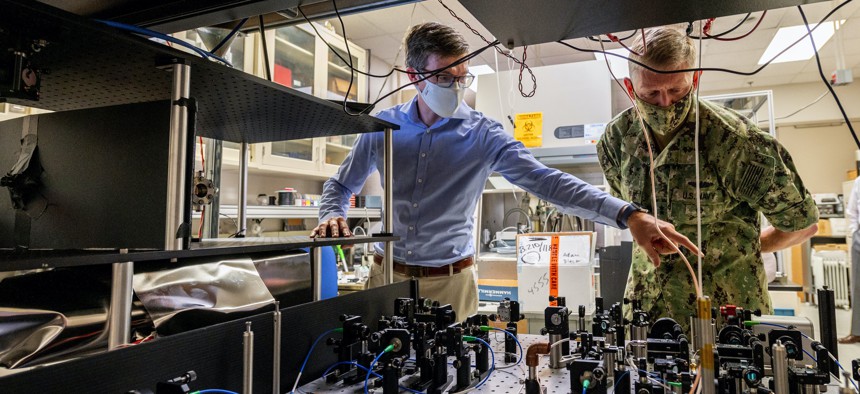
A U.S. Naval Research Laboratory research physicist, shows an atom interferometer to Chief of Naval Research Rear Adm. Lorin Selby Sept. 14, 2020, at Naval Research Labratory facilities in Washington, D.C. U.S. Navy / Jonathan Steffen
US Air Force, Navy Extend 50% Work-From-Home Indefinitely
New memos suggest office space occupancy may never return to 100 percent.
The U.S. Air Force is considering keeping in-person staffing at the Pentagon at just 50 percent even after the pandemic subsides, while the Navy issued policy Monday that keeps its occupancy at half for now, according to U.S. officials and documents reviewed by Defense One.
In a March memo describing the staffing changes, Air Force officials enshrined the notion of working remotely post-COVID, and outlined ways to reconfigure office space to put more distance between employees who must show up in person.
“Where the opportunity exists, you may consider placing a portion of your workforce on a more permanent telework schedule, and reconfiguring your office space into general use hotel suites that telework personnel can use when they need to come into the workplace,” said the Air Force memo, which was obtained by Defense One.
In addition, the Navy on Monday issued fleet-wide guidance that suggests occupancy rates will likely not rise above 50 percent in any of its shore facilities.
No Navy facility will permit occupancy to rise above half capacity until COVID-19 infection rates in the surrounding area report fewer than two new cases per 100,000 population for seven days in a row, said the guidance. Defense One obtained a copy.
The Army did not immediately respond to requests for comment.
The Pentagon is the world’s largest office building by square footage. Before the pandemic, about 23,000 people came to the building each day for work. But in March 2020, tens of thousands of those workers were sent home to prevent the transmission of COVID-19.
At the time, officials rushed to expand remote access to government networks. The forced experiment proved successful: nearly 90 percent of Pentagon employees say working remotely hasn’t hurt productivity. Now officials plan to roll out new telework technology.
Not all employees can work from home, particularly those that routinely deal with classified info.
The Navy will not be returning to 100 percent occupancy until its global pandemic order is rescinded, the guidance said. That’s because room occupancy levels are based on HPCON levels, for Health Protection Condition. Personnel would return to pre-pandemic staffing levels and room occupancies only if HPCON-0 is reached, where the “COVID-19 global pandemic declaration [is] rescinded,” the guidance said.
And if that happens, there will likely be supplemental guidance to follow, the Navy said.
The Pentagon is currently at HPCON-B, the condition prescribed when the local area has seen between two and 15 new reported cases of COVID-19 per 100,000 population over the last seven days. At HPCON-B, Navy offices can only report 50 percent occupancy, according to the guidance.
Each location’s health protection level is different based on the infection trends in their region. The instructions have not affected ship operations or ship occupancies throughout the pandemic, but each ship has taken precautions, such as cancelling port calls and restricting movement before deployment, to keep infections from occurring.
According to the Defense Department’s fiscal year 2021 budget request, 116 buildings make up the National Capital Region footprint, including the Pentagon Reservation, the Mark Center complex and the Raven Rock Mountain Complex, which serves as an underground bunker and emergency operations center for all the services.
Pre-pandemic, an estimated 64,000 people worked daily in those buildings, which held more than 14.6 million square feet of office space.
More detailed decisions about the Air Force’s remote working policy are expected in the coming weeks, a person familiar with the review said.



